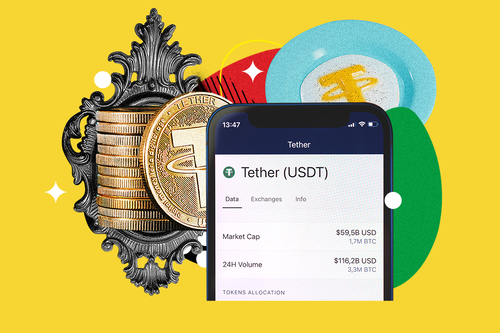

Wondering What the Safest Stablecoin Is? We've Got You
Tether is the most popular stablecoin, but it's risky. USDC and Dai are widely considered to be some of the safest stablecoins. Here's why.
Updated Jun 20, 2022
Many companies on MoneyMade advertise with us. Opinions are our own, but compensation and in-depth research determine where and how companies may appear.
Crypto
Global Markets
Technology
Stablecoins tout some pretty attractive benefits. As a cryptocurrency that's pegged to an external asset (and therefore stable), stablecoins are framed as the best of both worlds between traditional currency and crypto.
With stablecoins, you can put your trust in a centralized organization of crypto experts…or in your ability to judge and analyze a blockchain token.
People who invest in crypto like to convert a portion of their crypto into stablecoins to avoid crypto market volatility. What's more, crypto banks offer extremely high stablecoin interest rates, so you can keep your savings there and earn around 200x what you'd earn holding U.S. dollars in a traditional bank. But is it safe?
The debate around the safety and actual stability of stablecoins is alive and well. If you're looking for the safest stablecoin, here's what you need to know.
Are stablecoins safe?
Are stablecoins safe?
Stablecoins are considered safer than other cryptocurrencies, but determining whether or not a stablecoin is safe depends on how it's backed, its issuer, and the likelihood of future regulations impacting the stablecoin negatively. Not all stablecoins will fit your risk management strategy, so here's what you need to know before gaining exposure.
Backing
The backing of any given stablecoin determines how much it's worth and, thus, how likely it is to lose value. Unlike most cryptocurrencies, which are notoriously volatile, stablecoins are tied to the value of an external asset to make them, well, stable.
Stablecoins can be tied to a fiat currency, such as the U.S. dollar, another cryptocurrency, such as Bitcoin, or a commodity, such as gold. In theory, reserves of that asset are then kept on hand by the issuer to back the stablecoin's value. The safest stablecoins are cryptos backed by an external asset that's also considered safe.
Many consider stablecoins tied to the U.S. dollar to be the safest stablecoins due to the relative strength of the USD. To increase the safety of a stablecoin, an issuer will keep reserves of the pegged asset on hand. For that reason, stablecoins 100% backed by the asset they're pegged to are considered the safest.
Government regulations
The lack of regulations around stablecoins has made it easier for issuers to make false claims about their backing, which is a large part of what makes some of them potentially unsafe. However, this could change in the near future—and if it does, new regulations could impact the stability and value of some stablecoins.
Congress could pass measures requiring stablecoin issuers to adhere to banking regulations, particularly when it comes to making claims about reserve assets. Issuers who refuse or are unable to meet new regulatory requirements could see their stablecoins crash. That said, stablecoins that are able to meet regulatory requirements will likely become safer, more widely accepted, and more efficient.
Old fashioned...or really old fashioned?
Which would you put your trust in?
Transparency
While a fiat-backed stablecoin that claims it's 100% backed by reserves of USD might be theoretically considered the safest stablecoin, some issuers' claims about the backing of their stablecoins have been called into question.
For example, Tether (USDT), the largest stablecoin, came under fire for that very reason. Back when it was called Realcoin, the issuers claimed the stablecoin was backed 1-to-1 by the USD with reserves it kept on hand.
These claims were never verified, and an investigation by the New York state Attorney General years later found that the issuer covered up the loss of $850 million. And Tether's lawyer admitted that USDT was actually less than 75% backed. Further investigation found that, at times, there were no reserves whatsoever to back the value of Tether.
Is USDC safer than USDT?
Is USDC safer than USDT?
USDC is also fully backed by reserves independently verified by auditors. That's why USDC is considered safer compared to USDT.
Custodial stablecoins vs decentralized stablecoins
Custodial stablecoins vs decentralized stablecoins
Stablecoins that are backed by fiat currency or commodities are considered centralized or custodial stablecoins. This is because they're tied to a centralized asset and need to be controlled by a custodian (typically the stablecoin issuer). The custodian regulates the coin's asset reserves to make sure it's properly collateralized.
Being backed by fiat currencies or commodities can offer additional protection and stability (after all, the dollar is more stable than Bitcoin), but it also means these stablecoins aren't fully decentralized the way cryptocurrency is designed to be. Some investors see custodial stablecoins as less safe for this reason—when you purchase them, you're trusting the coin's custodian to properly manage its reserves and to avoid security breaches such as cyber-attacks.
On the other hand, stablecoins that are algorithmic (like Terra's UST) or crypto-backed are fully decentralized, and many proponents of DeFi (decentralized finance) claim this makes them safer. For example, while the popular stablecoin Dai is pegged to the USD, it's not backed by it.